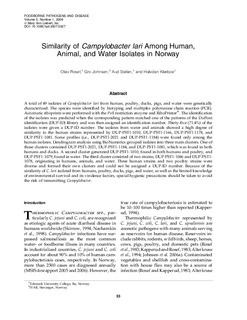| dc.description.abstract | A total of 49 isolates of Campylobacter lari from human, poultry, ducks, pigs, and water were genetically characterized. The species were identified by biotyping and multiplex polymerase chain reaction (PCR). Automatic riboprints were performed with the PstI restriction enzyme and RiboPrinter®. The identification of the isolates was predicted when the corresponding pattern matched one of the patterns of the DuPont identification (DUP-ID) library and was then assigned an identification number. Thirty-five (71.4%) of the isolates were given a DUP-ID number. The isolates from water and animals showed a high degree of similarity to the human strains represented by DUP-PST1-1010, DUP-PST1-1166, DUP-PST1-1178, and DUP-PST1-1081. Some profiles (i.e., DUP-PST1-2021 and DUP-PST1-1184) were found only among the human isolates. Dendrogram analysis using BioNumerics grouped isolates into three main clusters. One of those clusters contained DUP-PST1-2021, DUP-PST1-1184, and DUP-PST1-1081, which was found in both humans and ducks. A second cluster generated DUP-PST1-1010, found in both humans and poultry, and DUP-PST1-1079, found in water. The third cluster consisted of two strains, DUP-PST1-1066 and DUP-PST1-1078, originating in humans, animals, and water. Three human strains and two poultry strains were diverse and formed their own clusters and could not be assigned a DUP-ID number. Because of the similarity of C. lari isolated from humans, poultry, ducks, pigs, and water, as well as the limited knowledge of environmental survival and its virulence factors, special hygienic precautions should be taken to avoid the risk of transmitting Campylobacter. | |
